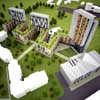Contemporary Welsh House, Sully Property, Penarth Building, South Wales Home Project Design
House in Sully, Barry, South Wales
Sully Residential Development Wales design by Richard Weston Studio, UK
8 Mar 2011
Sully House in Barry
Design : Richard Weston Studio
Location: between Barry and Penarth, just south of Cardiff, Wales
After almost giving up hope of finding a site for a house and studio, I unexpectedly came across an odd, left-over plot in an early 1980s development in Sully. Less than half a mile from the coast, the house will enjoy views of the Bristol Channel and Somerset hills – relayed via a webcam from the roof – and allow me to explore the vision of a synthesis of nature and architecture using digital technologies that has fascinated me for several years.
In 2010 this found another outlet when, following their second ‘Open Design Call’, I was invited to supply Liberty with ‘mineral scarves’. This booklet introducing the design for the house and studio has been made to mark the broadcast, commencing 29 March 2011, of ‘Britain’s Next Big Thing’, a BBC2 series tracing the development of my scarves and other new products.



images from Richard Weston Studio
The third-of-an-acre triangular site will become a ‘green island’ in suburbia. It is divided by a screen wall running east-west that frames a triangular south-facing garden. The house is arranged as an open linear volume to the north, with an inward-looking studio and living/reception spaces that look out across a series of shallow terraces descending to a waterlily pond. The irregular space around the house and garden will be planted to encourage wildlife.
Layers of nature
Sky: reflections in clear glass
Magnified minerals: silk in glass
Flying ducks: wood-strip silhouettes
Climbing plants: Boston Ivy
Magnified grass: laser-etched slate
The roof above the living and studio spaces is created by a four-bay half-portal steel frame, propped by a structural glass clerestorey to enable it to appear to float in space. Each bay has a rooflight that reveals the depth of the structure and allows sunlight to animate the upper section of the book-lined north wall. The rooflights sit above a coffee-table in the studio, the entrance, the long axis of the reception room and a window looking onto a ‘forbidden’ terrace in the dining area. A reflecting pool along part of the terrace will reflect dappled sunlight onto the ceiling. Images from quartz are used to mark the end of the studio and to line the kitchen wall, fittings and worktops.
Opening the front door you are greeted by a diagonal view that runs across the reception and dining spaces and out through a pair of patio doors. A distant strip of labradorite glass-in-silk echoes the large panel marking the entrance. A wide-screen television shares the centre of vision with the glass doors and will relay the webcam view of the Bristol Channel that would be visible to the naked eye if the doors were on the roof.
The studio is designed as a contemplative, inward-looking space framed on two sides by the agate image illustrated on the inside covers of this booklet. The image appears fragmentarily on the south wall, as silk-in-glass prismatic windows, a door to the garden, glazed slots, and large, linen-covered wall panels that wrap round to cover the west wall, where the image is broken only by two birch-ply doors. Above this intensely coloured agate, frozen for eternity, the clerestorey frames a fugitive frieze of sky.



images from Richard Weston Studio
In the corner of the studio, with glowing rooflight in place of spreading Pawlonia tree and labradorite ‘forest’ in lieu of Lac Leman, the coffee table is made in emulation of the magical place Le Corbusier created in the garden of the house he built for his parents in 1924.
Seen from the studio the rooflights seem almost monumental, revealing an unexpected thickness to the roof construction – the fact that it tapers to a shallow gutter along the south front can be seen only from outside. One of the two prismatic bay windows is placed opposite the entrance as a welcome on arrival; beneath it will be a display of agates that, like the window, will be backlit at night.
House in Sully – Building Information
Architect: Richard Weston (richard weston studio)
Structural engineer: Ian Jones (Burroughs, Cardiff)
Enironmental engineer: Paul Hinam (Gallese Design, Barry)
Contact: [email protected]
Web: www.richardwestonstudio.com
www.naturallyexclusive.com
www.earth.uk.net
Facebook: www.facebook.com/WestonStudio
CAD model and images by Andrew Morrison
House in Sully images / information from Richard Weston Studio
Location: Sully, South Wales, UK
Architecture in Wales
Contemporary Architecture in Wales
First UK zero-carbon Passivhaus The Larch House, Wales
Design: bere:architects

image from architect
Welsh Eco House
Welsh Housing Competition : Lawrenny Sustainable Housing Development
Welsh Building Competition : Glyndwr University, Wrexham

image © 1AX Architetti Associati
Welsh Architecture – Selection
Aberystwyth Creative Units
Design:Heatherwick Studio

photo : Edmund Sumner
Aberystwyth Creative Units
Welsh National Assembly, Cardiff
Design:Richard Rogers Partnership

picture : Katsuisha Kida © The Photographer
National Assembly for Wales
Ruthin Craft Centre, Ruthin
Design:Sergison Bates Architects

image : Dewi Lloyd © Ruthin Craft Centre
Ruthin Craft Centre
Hafod Eryri
Design:Ray Hole Architects

image from architect
Snowdon Summit Visitor Centre
Comments / photos for the House in Sully Wales Architecture page welcome




